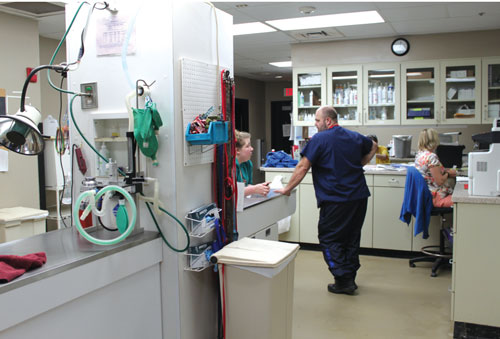COE to examine guidelines for distributive model
Although the distributive clinical education model has been used in veterinary education for more than a decade—and much longer in other medical fields—the AVMA Council on Education, the body that accredits veterinary colleges continues to field questions from practitioners about how the model works and how it is assessed.
Under a distributive model, students receive all or a substantial part of their clinical education at off-campus sites such as private practices, federal and state agencies, and other entities, rather than at a traditional, on-site veterinary teaching hospital.
The Western University of Health Sciences College of Veterinary Medicine in Pomona, California, was the first veterinary college in the U.S. to adopt a full distributive clinical education model; the college was first accredited in 2008. More recently, Lincoln Memorial University College of Veterinary Medicine in Harrogate, Tennessee, adopted a hybrid distributive model, with students learning clinical skills both at the on-campus DeBusk Veterinary Teaching Center and at off-site clinical affiliates associated with the college. LMU received a letter of reasonable assurance of accreditation from the COE in 2013.

Some practitioners have questioned how the AVMA COE assesses the level of clinical instruction provided at these off-site facilities and whether the training is comparable to that provided by an on-site veterinary teaching hospital.
Dr. John Scamahorn, chair of the COE, gave an explanation during a listening session held Aug. 7 by the council during AVMA Convention 2016 in San Antonio.
According to Dr. Scamahorn, all veterinary colleges must identify their core instructional sites, consisting of the sites students are required to attend to receive clinical education. Each time a college is assessed, COE site visitors will visit each of the core instructional sites and fully evaluate them to ensure they meet all the COE standards.
At Western, for example, the site visit team added extra members and split up into four groups. They visited Denver, Phoenix, San Francisco, and San Diego to assess the veterinary college’s core instructional sites. They then met at the campus to complete the site visit.
Notably, regardless of whether a college has an on-site veterinary teaching hospital, the council’s site visit teams do not go to sites where veterinary colleges have elective externships or preceptorships or other elective educational opportunities.
“As we all know, the majority of schools do not do everything in-house anymore. Even a teaching hospital sends students off-site for certain educational opportunities,” Dr. Scamahorn said. For example, some veterinary colleges with teaching hospitals do not have sufficient resources to teach students food animal medicine, and students are required to go to off-campus sites to receive instruction in those skills. If that happens, he said, those sites will be evaluated by COE site teams.
Two sections in the COE’s accreditation policies and procedures manual deal with distributive sites for veterinary colleges and can be found here. Over the past year, the council has had a working group review these sections to determine whether any revisions are necessary. The working group was expected to provide recommendations on any changes to the guidelines for the council to consider at its Sept. 25-27 meeting. Should the council decide to amend either section on the basis of the working group’s report, those changes would then go out for stakeholder input, Dr. Scamahorn said.
As a result of input from stakeholders, the COE created two other working groups this past year that were also to report their findings at the September meeting. One is on diversity; the other is on student financial literacy. The AVMA House of Delegates discussed the latter at its regular annual session in August in San Antonio and supported the council’s action in this area (see JAVMA, Oct. 1, 2016).
In the coming year, the council also plans to review its standards on admissions, faculty, and curriculum as part of its regular review cycle. Public comment will be sought and considered prior to final approval by the COE of any proposed changes.
The council continues to wait for word on when the secretary of Education will sign off on continuing recognition of the COE as an accreditor, as recommended by the U.S. Department of Education’s National Advisory Committee on Institutional Quality and Integrity. The council will have to start the five-year cycle for reauthorization once again in 2017.
A full transcript of the listening session is available here (PDF).
Related JAVMA content:
Committee recommends COE remain a college accreditor (Aug. 15, 2016)
LMU models itself on the best (Aug. 15, 2016)
WesternU receives full accreditation; decision made on UNAM (April 1, 2010)